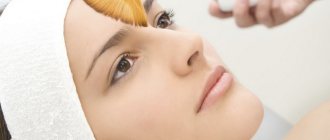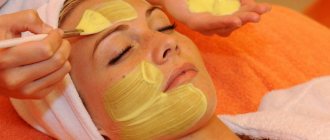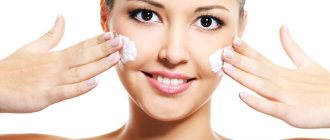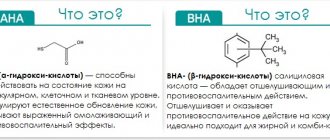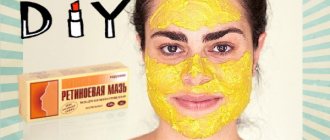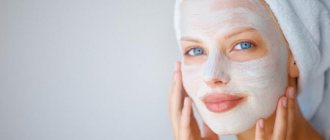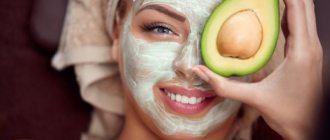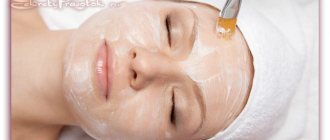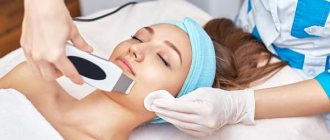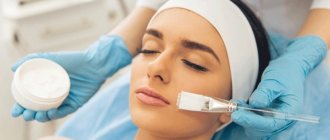Currently, an increasing number of girls are choosing a worthy alternative to salon cosmetology procedures - carrying out the procedure themselves. To make it easier for you to carry out the procedure at home, I will tell you how to properly do chemical peeling at home, and what cosmetic products are best to use.
Chemical peeling is performed independently using drugs containing fruit acids, which allow you to exfoliate dead particles of the epidermis, and makes the skin smooth and soft. More often, homemade chemical mixtures are not very concentrated and affect only the upper layers of the dermis, therefore they are safe and painless. Procedures with deeper cleansing should be carried out in the experienced hands of a specialist who can choose the composition that is optimal for the characteristics of your skin.
Performing the procedure allows you to:
- Cleanse your face of dead particles of the epidermis.
- Increase tone and eliminate fine wrinkles and folds.
- Improve complexion, remove pigment traces.
- Normalize the secretion of the sebaceous glands.
- Remove the effects of acne.
Types of procedure
Depending on the depth of skin cleansing, the tools and compositions used, peelings are divided into the following types:
- Surface
The safest method, since it affects only the surface layers. Removes pigment spots, acne marks and age-related changes. Often used as a preventative measure.
- Median
Affects the deeper layers of the epidermis. Initially used only in beauty salons. But if you follow all the rules and recommendations for the procedure, it is possible to perform the procedure at home. Able to eliminate pronounced skin defects, such as scars, scars, post-acne, wrinkles and age spots.
- Deep
The most radical method is used only at an appointment with a cosmetologist. Deep chemical facial peeling is not used at home due to the complexity of the procedure; for safety reasons, it is better to turn to professionals, since doing it yourself can lead to more serious consequences.
How to do it?
Chemical peeling is not a cheap procedure, so in an attempt to achieve perfect skin, many resort to peeling at home. Noticing the growing demand for home treatments, many cosmetics manufacturing companies began producing home care products.
Unlike more superficial procedures, chem. peeling can leave behind quite unpleasant consequences, so it is important:
- weigh all its advantages and disadvantages;
- study contraindications;
- take into account the risk of complications;
- choose a suitable remedy;
- act as carefully as possible.
Compositions for home use offered by cosmetics manufacturers differ from salon formulations in having a lower concentration of acids and are considered safer. By following the instructions, you can achieve excellent results that are not inferior to professional care.
Advantages and disadvantages
The benefits of acid peels at home are:
- Saving money. For home use, you can either purchase ready-made formulations, fruit juices or some inexpensive pharmaceutical drugs, such as aspirin and salicylic acid. And since the procedure is carried out independently, money is saved on paying for the services of a professional cosmetologist.
- Save time. You can carry out peeling at home at any convenient time: you don’t have to make an appointment with a cosmetologist in advance and plan your activities depending on the time of cleansing.
We recommend: What is soda peeling? How to carry out a procedure for hair and face at home?
Home peeling also has serious disadvantages:
- An incorrectly performed procedure, inappropriate acid composition, excessive exposure time and insufficient experience in cosmetic procedures significantly increase the risk of serious skin burns and subsequent complications.
- A procedure performed once at home will not provide the same results as in a professional cosmetologist's office - this is due to the fact that formulations for home use contain a lower percentage of acids. Therefore, systematic implementation may be required.
Acid peeling at home is unlikely to replace a similar procedure performed by a professional. Nevertheless he:
- will help correct some skin problems;
- prevents deepening of wrinkles;
- will get rid of blackheads;
- delays the manifestations of premature aging of the skin.
Indications and contraindications
Cosmetologists advise facial peeling at the first signs of skin aging.
Indications for performing the procedure are:
- dull skin color, sickly gray tint;
- decreased skin turgor, sagging;
- sagging soft tissues, loss of elasticity;
- blackheads, acne;
- enlarged pores;
- oily skin;
- expression wrinkles;
- stretch marks (striae).
Before deciding to undergo chemical exfoliation, you should contact a professional cosmetologist to understand whether there are indications for the procedure. In addition, a specialist should examine the skin for contraindications.
Contraindications to chemical peeling:
- allergic reaction;
- the presence of an inflammatory process, wounds and damage to the skin of the face;
- acne in the acute stage;
- herpes;
- papillomas and oncological neoplasms;
- exacerbation of chronic diseases;
- increased body temperature and feverish state;
- any deterioration in health;
- period of menstruation, pregnancy and lactation;
- age under 18 years;
- taking hormonal drugs.
After making sure that there are no contraindications to chemical exfoliation, you can begin to choose the appropriate product.
Products for the procedure at home
The composition for home chemical peeling can be made independently , although manufacturers offer a wide selection of ready-made preparations. You can buy the necessary components at the pharmacy.
The most popular are:
- Mandelic and glycolic acids. They stimulate metabolic processes in the epidermis, act relatively gently and are suitable for dry, weakened skin.
- Fruit acids (mixtures of apple and strawberry, lemon and any other sour fruits and berries).
- Salicylic acid/aspirin (concentration from 2% to 30%).
- Calcium chloride (5–10%).
- Lactic acid.
- Retinolic acid.
It is worth noting that fruit peeling is the softest, gentlest and least effective, and pharmaceutical acids should be used with caution to prevent burns.
In order not to get confused in recipes for preparing formulations and not to worry about whether all proportions are correct, you can purchase ready-made preparations for exfoliation.
We recommend: Indications, implementation and effectiveness of hand peeling. The best recipes and remedies
The manufacturer Biomatrix (France) offers the following compositions:
- glycolin 50%;
- mentalin 50%;
- anti-aging peeling ph 1.5;
- ferulin;
- glycoliposom 70% pH 2.3;
- jessner.
Spanish-made drugs are also popular:
- Multipeel milk peeling with lactic, citric, glycolic, tartaric and malic acid;
- glyco active peel 70%;
- piruvin with pyruvic acid;
- mindaliposom 70% - almond peeling with liposomes.
Ready-made preparations are considered more effective and safe - their acid content is higher than in homemade formulations, there are instructions for use and a list of contraindications.
Step-by-step instructions: how to apply the composition?
To begin with, we note that 2 weeks before exfoliation, you should limit your time in the sun and apply a special cream to the skin that will prepare it for the application of the acid composition.
Reference! Before the procedure, you should conduct a sensitivity test: to do this, apply the mixture to the inside of your elbow or wrist and leave for 15–30 minutes. If there is no discomfort or signs of an allergic reaction, you can begin the procedure.
Step-by-step instructions for performing chemical peeling at home:
- Makeup remover The skin should be thoroughly cleansed of makeup and surface contaminants - to do this, simply remove makeup with a special product and wash with gel.
- Warming/steaming the skin. Professional cosmetologists perform vaporization with a special apparatus, and at home you can simply put a towel soaked in hot water or herbal decoction on your face for 3–5 minutes.
- Application of the drug. The composition is applied with a cotton pad, sponge or brush, carefully avoiding the area around the eyes and lips.
- The composition is left on the skin for 3–5 minutes. Longer exposure may cause skin irritation and burns. During the process, a slight burning or tingling sensation may occur - this is normal, but if severe discomfort occurs, you should immediately wash off the composition with water.
- The peeling is washed off first with warm, then with cold water.
- A regenerating agent is applied to the skin, and after 10 minutes a moisturizing or nourishing cream is applied.
After the procedure, during the entire recovery period, you should use a protective UV cream before each time you go outside, especially in the sunny season.
Security measures
Acid exfoliation is a fairly serious procedure , during which you need to follow safety precautions:
- Before applying the composition, a sensitivity test should be performed. If an allergic reaction occurs on the skin, the procedure will have to be abandoned.
- The optimal time for exfoliation is late autumn and winter. The fact is that the sun at this time does not have such a strong effect on damaged skin.
- When choosing a peeling product, you should pay attention to the composition, concentration of acids and decide based on the individual characteristics of your skin type.
- The exfoliation composition should be applied evenly in a thin layer, avoiding the lips and eyes.
- Before you begin the process, you need to study the instructions for use: find out the exact time of application of the drug and contraindications.
- When exposed to acids, a burning and tingling sensation occurs, but if painful symptoms appear, you should immediately wash the composition off your face.
- It is unsafe to use drugs for professional use.
- Chemical peeling at home should be carried out in courses, but not more than once every 10–14 days.
- Acids damage the epidermis, so after home cleaning you should not touch your face with your hands - it is better to wash your face with thermal water sprays.
- During the recovery period, you should not use creams and masks containing acids, fragrances and abrasive particles.
- Scrubbing and any cleaning is unacceptable and can lead to the formation of wounds and scars.
We recommend: Acid facial peeling with aspirin. Recipes and features of the procedure at home
Determining the frequency of the procedure based on skin type
- Dry
Girls with this skin type should not overuse chemical facial cleansing. It is enough to perform the procedure every seven to nine days. It is better to give preference to products that contain alpha hydroxy acids. They help the skin more easily absorb nutritional ingredients after cleansing.
- Combined
Women with a combination type, that is, who have certain areas of the face that are dry, such as the cheeks, and others that are oily, such as the T-zone, should cleanse after 4-5 days. During this period, the epidermis has time to fully recover, and the effect of the procedure does not decrease.
- Fat
For girls with an increased level of secretion from the sebaceous glands, it is preferable to carry out chemical peeling after three days. This frequency does not provoke the appearance of inflammation and redness, and ensures proper cleansing. Choose products containing salicylic acid, it regulates the secretion of the sebaceous glands well.
Rules and recommendations for chemical peeling at home
- Test for an allergic reaction. Apply a little mixture to the area under the elbow and leave it on for as long as the procedure lasts, then rinse. If no inflammation occurs, then you can safely move on to chemical peeling.
- Perform the procedure in the appropriate season. Simultaneous exposure to peeling agents and direct sunlight is incompatible. It is preferable to perform procedures in autumn or winter, when the sun is not so bright.
- To ensure the safety of the skin surface, apply the composition in a thin, even layer.
- Perform pre-cleaning. Remove any remaining makeup with lotion or other product you are used to.
- Do not apply the composition to your eyelids. The area around the eyes is one of the most sensitive, so to avoid redness and inflammation, do not apply the mixture to these areas.
- If there is an excessive burning sensation, you should shorten the procedure time and immediately rinse off the drug with cool water.
- You should not cleanse this way more than ten days.
- If you have a particularly sensitive skin type, you should not peel the deep layers of the epidermis.
- For the first twenty-four hours after cleansing, avoid using cosmetics and try not to touch your face.
Possible consequences
The consequences of peeling are divided into expected and unexpected.< The appearance of the former is predictable, and the latter is considered a deviation. We list the main predicted consequences:
- peeling;
- swelling;
- redness;
- feeling of dryness and tightness of the skin.
If you do not interfere with the recovery process (do not rip off the scabs, do not comb the skin), the consequences will go away in a few days.
Important! If swelling occurs, you can apply a hypoallergenic gel. And if wounds form on your face, you should immediately consult a doctor.
Unexpected consequences include:
- Quincke's edema;
- severe allergies;
- herpes;
- persistent erythema;
- the appearance of scars;
- marble shade of mozhi.
The negative effects of peeling are difficult to eliminate; they can cause damage not only to appearance, but also to health.
Contraindications to chemical peeling
You should avoid using this cleansing method if you have the following diseases or conditions of the body:
- Aggravated phase of acne or acne.
- Individual intolerance to one of the components of the composition.
- Active phase of herpes.
- The presence of inflammatory processes in the treated area.
- High skin sensitivity.
- Diseases of the heart and blood vessels.
- Mental abnormalities.
- Pregnancy and lactation period.
- High body temperature.
- During menstruation.
- For rosacea.
- Deviations in the functioning of the thyroid gland.
Indications and contraindications
It is recommended to carry out home facial peeling with acids at the first signs of skin aging. Indications for chemical exfoliation include:
- grayness, dullness of the epidermis;
- flabbiness, decreased natural tone;
- loss of elasticity of soft tissues, their sagging on the cheeks;
- frequent single rashes, acne and comedones;
- clogged and enlarged pores, blackheads on the face;
- first facial wrinkles;
- oily skin shine.
Before doing facial peeling with chemical compounds, consult a specialist to see if it can be done and how to do it correctly, without complications. During the consultation, the cosmetologist will examine your skin for contraindications.
It is unacceptable to perform facial peeling at home in the following cases:
- there is an allergy to the components of the product;
- for ulcers, wounds on the face, as well as for exacerbation of acne;
- there is herpes on the face or there are oncological tumors, papillomas;
- there is inflammation in the treated area;
- for disorders of the nervous system and severe disorders of any of the body systems;
- during exacerbation of chronic diseases:
- the patient feels unwell and has a fever;
- during pregnancy and lactation;
- at an early age (up to 18 years).
It is recommended to postpone the procedure during menstruation or when taking hormonal medications. During this period, the effect may be unexpected or completely absent.
What you will need to complete the procedure
Most of the tools are present in every girl’s home; other products can be purchased in the Alpika online store. You will need:
- Soft towel.
- Skin prep toner.
- Compound.
- Product for restoring pH balance.
- Cream for moisturizing and protecting against UV rays.
- Petrolatum.
- Brush or cotton swabs for applying the mixture.
You can prepare your own chemical facial peel recipe at home, but I strongly advise you to purchase a ready-made product. Since it contains the optimal concentration of components for a certain skin type. If you prepare it yourself, you may not distribute the ingredients correctly and cause serious harm to your skin.
After purchasing all the necessary tools, you can proceed directly to the cleansing procedure.
Step-by-step technology
- Wash your hands with soap.
- Remove makeup and cleanse your face with your usual product (tonic, foam, gel, etc.).
- Wash your face with water and dry your face with a towel.
- Apply Vaseline to the eye area, lips and eyebrows. This will help protect delicate areas from the effects of the drug.
- Read the recommendations for using the peeling product and strictly follow the application instructions.
- Using a brush or cotton swab, apply the composition first to the nose and chin, then to the forehead and cheeks. Make sure that the mixture is evenly distributed.
- Leave the product on the skin for the time indicated in the instructions. For the initial procedure, a minimum period of time is sufficient; depending on the frequency of use, you can increase the amount of time.
- Monitor your skin's reaction; if you feel any discomfort, remove the product immediately.
- After time has passed, rinse off the product with cool water or a special tonic that neutralizes the effects of acids.
- Treat your face with a product to restore pH balance.
- After the product is completely absorbed, apply a moisturizer.
Skin care after chemical peeling at home
To obtain the maximum effect from the procedure, it is necessary to perform a number of additional operations for timely restoration of the skin.
- Try to minimize hand-to-face contact in the first twenty-four hours after the procedure. If you cleansed during the day, then give up your usual evening care, that is, do not apply cream or mask. If there is excessive secretion of the sebaceous glands, simply blot your face with a paper napkin.
- If after a day there are still redness and inflammation on your face, you can reapply skin-soothing products (masks, creams).
- Avoid using decorative cosmetics in the first three to five days after the procedure.
- Use UV protection and try to spend less time in direct sunlight.
- Remember that you can take the course once in one year.
- The frequency and number of sessions are determined based on the characteristics of the skin and the severity of the defects.
What results can you achieve?
- Cleansing clogged pores from sebaceous plugs.
- Reducing the number of comedones.
- Increased skin elasticity.
- Exfoliation of dead particles of the epidermis.
- Stimulating the production of elastin and collagen.
- Accelerating the process of cell regeneration.
- Elimination of post-acne and defects that arose after acne healing.
- Removing pigment spots.
- Getting rid of wrinkles and crow's feet.
In order to achieve all the results listed above, it is necessary not only to follow the rules and recommendations for the procedure, but also to select a preparation that is suitable for the individual characteristics of your skin. In this matter, it is better to trust professionals who develop in detail cosmetic products suitable for a specific skin type and aimed at solving specific problems. The products allow you to carry out effective chemical peeling at home, which is not inferior to the procedures of a beauty salon.
| Problem | Solution | Means |
| Dry sensitive skin | Multivitamin with gentle action, contains only 5% succinic acid. | Pro Quick view 80 ml Multi-acid peeling with succinic acid 5% (pH 3.5)Only for PROF |
| Slow skin recovery after the procedure | Almond oil stimulates the process of cell regeneration. Aloe extract reduces inflammation and has a bactericidal effect. | |
| UV protection required | An emulsion containing hyaluronic acid daily protects the skin from photoaging. | Quick view 50 ml |
Popular acid attack methods
Almost all superficial exfoliations performed in a beauty salon can be performed at home without any problems. Cosmetic companies have taken care of their customers and offer separate product lines for home cleansing. Inside each preparation there are instructions with a detailed description of how to do peeling correctly.
Let's consider several popular and worthy methods for home use.
Jessner Peel
One of the most popular acid procedures in modern cosmetology is yellow peeling or Jessner peeling. The composition for facial exfoliation includes several acids at the same time (lactic, salicylic and resorcinol). Their complex action deeply cleanses the skin, normalizes metabolic processes, activates collagen synthesis and prevents the appearance of pimples and blackheads on the face.
The full course of this type of exfoliation is conditionally divided into 3 stages:
- Deep cleansing and acceleration of intracellular processes.
- Rejuvenating effect, correction of facial surface relief.
- Fights extensive acne, deep wrinkles and age-related defects.
Each stage differs in the number of layers of application of the peeling agent and, accordingly, the depth of impact on the skin. However, the algorithm of actions is the same:
- Cleanse your face of oil and dust.
- Apply an exfoliant.
- Neutralize the acid.
- We remove the remaining acid preparation.
- Soothe the skin with moisturizer.
For the first stage, one layer is enough, for the second - two and for the third - three. Each subsequent layer is applied 5 minutes after the previous one. For patients with sensitive skin, the third layer is applied after a short period of time to prevent the appearance of wounds on the face.
Skin care after peeling is an equally important stage of the procedure. To avoid unpleasant marks on your face from acid exposure, adhere to the following rules:
- After exfoliation, wash with acidified water. Movements should be as soft as possible, non-traumatic;
- do not peel off peelings and crusts formed after a chemical burn, wait for their natural rejection;
- do not visit the bathhouse, solarium, sauna and swimming pool, postpone physical activity and sports until the skin is completely restored;
- For a month, avoid sunbathing, avoid direct rays of the sun;
- use sunscreen cosmetics every day for 3-4 months to prevent pigmentation from appearing on your face;
- do not use decorative cosmetics in the first 7–10 days;
- Do not use cosmetic products containing alcohol, aggressive chemical additives, or fragrances until the skin is completely restored.
Milk peeling
Lactic acid is contained in small quantities in the cells of the epidermis, so the cleansing technique of the same name is easily accepted by the skin, as a rule, without complications and lengthy rehabilitation. Let's look at how to do a chemical peel with lactic acid at home:
- 2 weeks before the planned cleansing, postpone sunbathing, and add a cream with a small amount of lactic acid to your daily care.
- Check how the skin reacts to the acidic composition: apply a little product to your wrist and wait for the reaction. Severe burning, pain and irritation are unacceptable.
- Cleanse your face with tonic or cleansing gel.
- Apply a diluted milk solution (lactic acid concentration should not exceed 10%). Do this with cotton swabs in parallel stripes from the forehead to the chin. It is important to distribute the composition evenly so as not to burn out individual areas.
- For the first procedure, limit yourself to 1 minute of exposure to the skin, then increase this time to 3 minutes.
- To neutralize the effect of the acid, treat your face with a weak alkaline solution (1 teaspoon of baking soda per 200 ml of water). Rinse off any remaining medication with plenty of water.
- Moisturize your face with cream.
Carry out the next cleansing procedure at least 7–10 days later. In general, the course of peelings is up to 5 procedures.
The main rule of the rehabilitation period is that you cannot use products containing retinol, and in the first days, fatty creams are also unacceptable. Otherwise, the recommendations are general: no thermal effects (baths, saunas, compresses, physical activity) and intensive hydration of damaged tissues.
Glycolic peeling
This type of cleansing is safe and hypoallergenic. The procedure allows you to improve metabolism in epidermal cells, smooth out wrinkles and folds on the face, even out your complexion and eliminate acne problems. Visible changes will become noticeable after just a few procedures.
This type of exfoliation will be useful at 25 and 45 years of age. Glycolic acid with a concentration of 10–15% is used for cleansing.
Glycolic acid peeling is performed in the following order:
- The face is cleaned of dust and makeup particles.
- To degrease the skin, the face is additionally wiped with a lotion based on glycolic acid (5%).
- An exfoliant (glycolic acid up to 15%) is applied to the skin in an even, thin layer. Wrinkles and problem areas can be re-treated. Use cotton swabs to apply the product. Start peeling from the forehead area, gradually moving down to the chin. It is better not to touch the sensitive area around the eyes, eyelids and lips.
- After applying the product, wait a while for the ingredient to take effect. Then apply a neutralizing gel. Rinse off the remaining acid composition with warm water.
- Secure the result with a natural nourishing mask and moisturizer.
Cosmetologists recommend carrying out the procedure in courses (up to 10 sessions) with an interval of 1–1.5 weeks.
Attention! Do not increase the acid concentration above 15% to avoid causing a severe chemical burn. For more pronounced results, contact a specialist, because doing deep peeling at home is very dangerous.
